What age for sleeping in a bunk bed?
Categories:
Children's Room
 How to attach a headboard (with or without drilling): quick and effective soluti
How to attach a headboard (with or without drilling): quick and effective soluti
 Waterproof sheet or mattress protector: the best solution by age group
Waterproof sheet or mattress protector: the best solution by age group
 27 Original, Useful, and Trendy Christmas Ideas for Teens 2025
27 Original, Useful, and Trendy Christmas Ideas for Teens 2025
 Christmas Activities for Baby: Creative Ideas for Home & Daycare
Christmas Activities for Baby: Creative Ideas for Home & Daycare
 When to put up Christmas decorations for extended magic?
When to put up Christmas decorations for extended magic?
Adopting a bunk bed represents a practical layout solution that meets many specific needs. It allows for space-saving while prioritizing comfort.
Moreover, it is also an appropriate alternative to optimize children's cohabitation as two or more children can sleep in the same room. Nevertheless, given the structure of the furniture and especially the height, each parent must be able to know at what age a child can safely sleep in a bunk bed.
Opinions on the age to be able to sleep on a bunk bed are unanimous. A child must be at least 6 years old to use this type of furniture, especially the upper bunk. Indeed, before this age, safety is too poorly optimized as the risks of falls and accidents are too high. Certainly, the bed is equipped with protection such as barriers and ladders to ensure safety in the top bunk. However, nothing beats caution, hence the age defined as 6 years to use this type of bedding, especially the top bunk.
Logically, the safety rule wants the oldest to take the top bunk. Obviously, the youngest will argue with their elder and it will be a subject of bickering between siblings, but respecting this hierarchy would be better for them. The oldest takes the top bunk and the little one at the bottom so they can have their autonomy, especially since for the little one, this bed could be considered as a small cabin. Thus, they will find joy in spending time on their small bed, from as early as 3 or even 2 years old.
Now that you know the age for sleeping in a bunk bed, you still need to know what ceiling height to respect for adequate bedding. First, to better choose the sleeping furniture, it is also necessary to evaluate the right ceiling height in order to adapt it well. This includes the dimensions of the room, as well as the configuration of the room. This also represents a criterion for enhancing the safety of sleepers.
By observing a good ceiling height for the top bunk, you maintain a good distance preventing the head from hitting the ceiling each time the sleeper gets up at night or in the morning. As a general rule, the gap between the mattress surface and the ceiling should be at least 60 cm to prevent them from getting a bump on the forehead during their moments of play and rest.
Respecting the ceiling height is mandatory, especially for rooms located under slopes. In this specific case, the safety rule requires that it be a mid-height bunk bed since the available ceiling height is reduced.
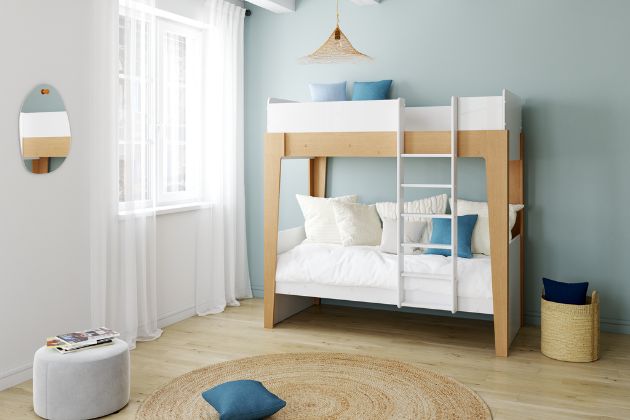
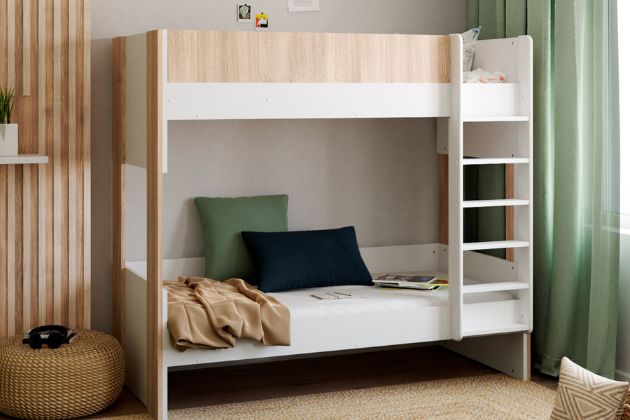
Parents frequently ask a question: "is a bunk bed suitable for a teenager?". Indeed, they want to know the age limit for sleeping in such furniture. In fact, no rule defines the answer to this question, and there is no absolute truth as it depends on the space available in your home. Besides that, it also depends on the child's needs in terms of development and emancipation. Some situations force parents to let the child sleep in this bed due to lack of available space. They are not offered any choice to give them a particular room.
Nevertheless, there is a solution to offer the teenager more spacious bedding to give them more comfort adapted to their size in small spaces. This involves choosing bed sizes of 1.5 place (120 x 200 cm), so that the furniture can accompany them until adolescence.
Otherwise, dismountable bunk beds represent a practical solution for a large sibling group. Thus, once a room becomes available, the sleeping arrangements can be separated to form individual beds that will be integrated into a room to give the child more privacy.
The bunk bed is generally intended for children or teenagers to optimize space. Despite all the selection factors, other criteria must be taken into account to choose the most suitable and safest bunk bed for the child during sleep.
Whether the bed is intended for young or older children, securing the upper bed represents a fundamental selection criterion. This results from the fact that during the night, an individual, child or adult, tends to wiggle and move in all directions. Therefore, the top bunk must be well secured with safety barriers on all lengths and widths of the bed. It is in fact about creating a protective frame (bars) aimed at preventing the sleeper from falling out of bed.
Moreover, this criterion is part of European safety standards.
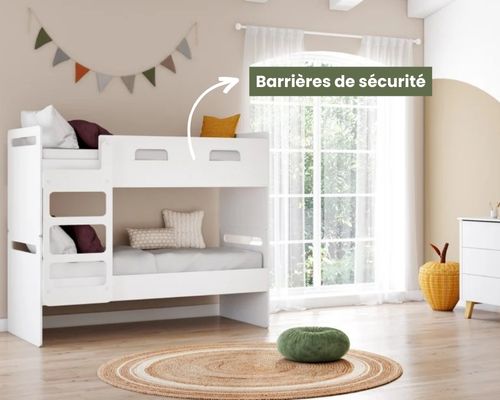
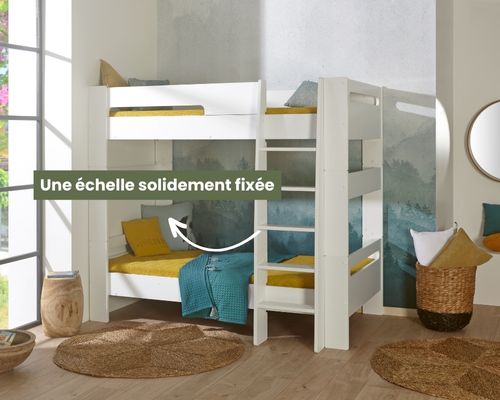
For optimal safety, the access to the loft bed must be simple, but secure. At a certain age, children can be quite aggressive and also like to climb. As a result, they will see the ladder as an element for venturing up and down the bed throughout the day. In this case, the stability of this access is crucial for the descent and ascent to be totally secure, hence the importance of favoring fixed accessories for optimal stability.
The choice of bunk bed also depends on the right height between the two sleeping areas. This is part of the safety criteria to prevent the child from hitting their head on the bed base of the top bunk when getting up.
Furnishing the children's room with a designer bunk bed saves space, but for more comfort and safety, the children's loft bed should be equipped with a safety barrier.
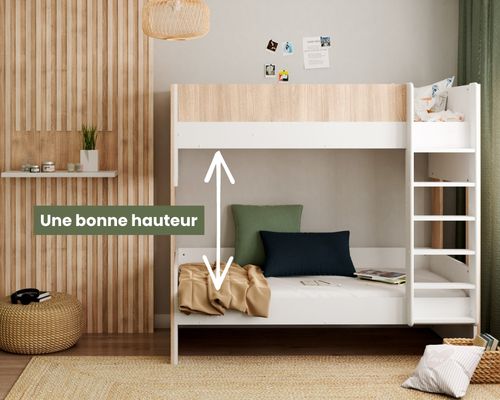
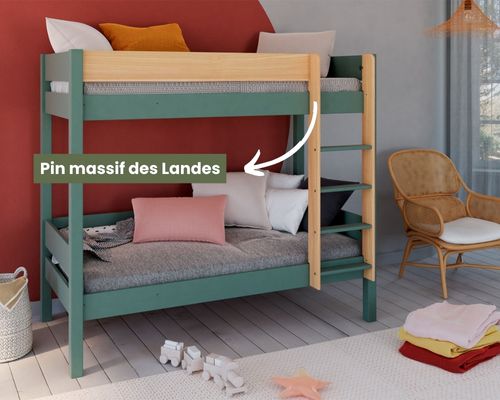
Safety is a major criterion for choosing a bunk bed, hence the need to favor a robust and stable structure in the children's room. Especially since it is furniture intended to accommodate two or three children.
Thus, quality materials (solid wood, metal) represent a factor of resistance. Besides the structure, the bed base must also be robust, especially for the upper bunk.
Finally, the option that can be taken into account will be the storage side of the bunk bed. To better optimize space, you can favor beds equipped with integrated storage compartments. This could be wheeled drawers at the bottom of the bed, simple storage drawers, or even closed or open niches at the ends of the bed.
Otherwise, to have a functional children's bed at each level, the bed bases must be comfortable. The same goes for the sheet, mattress, pillow, pillowcase, or duvet to make it a cozy cocoon.
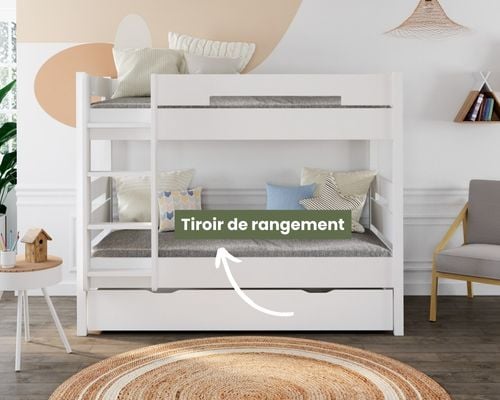
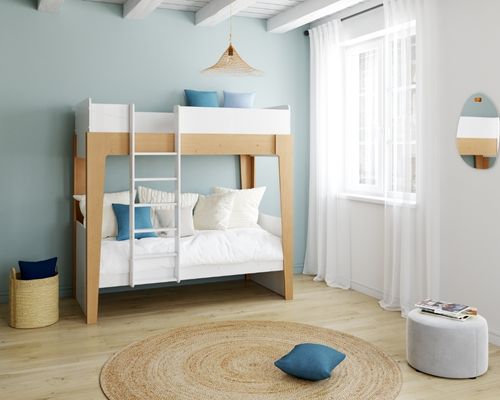
The choice of bunk bed must also take into account the manufacturing materials. Natural wood, including pine, solid beech, oak, spruce, birch or fir are all essences to be favored. Otherwise, MDF particle boards can also be used for a children's bunk bed. You just need to make sure that the top bunks meet safety standards so that the bedroom is a true haven of peace.
